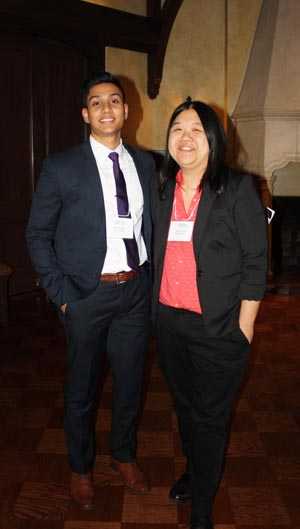
Features
Associations
Business
OPIA Meeting Focuses on PIA Affiliation and Rise of Auxiliary Services
February 25, 2014 By Krista Brown
 Come into the digital world or you may fall behind was a key message delivered by two Canadians, Jeff Ekstein and Michael Makin, representing the Printing Industries of America at last week’s Ontario Printing and Imaging Association meeting.
Come into the digital world or you may fall behind was a key message delivered by two Canadians, Jeff Ekstein and Michael Makin, representing the Printing Industries of America at last week’s Ontario Printing and Imaging Association meeting.
The February 19 dinner meeting with these two senior-level PIA executives was held at the St. Georges Golf and Country Club in Etobicoke, Ontario, and included an enthusiastic crowd with some of Ontario’s leading commercial printers and technology suppliers. In November 2013, Ekstein, President and CEO of Willow Printing Group in Concord, Ontario, was elected as the 2014 Chairman of the Board for PIA, one of the world’s most-powerful printing associations. Makin, born in Montreal, has been President and CEO of the PIA since 2002.
The dinner meeting agenda was set to also update members about the OPIA’s earlier decision to become a direct member affiliate of the PIA. The main points of discussion from Ekstein and Makin, as well as OPIA President Tracey Preston, were how OPIA/PIA together can help printers run their businesses. As the evening progressed, this theme narrowed in on how printers can offer auxiliary services to customers and stay ahead of your competition.
 One of the major setbacks with the perception of today’s media buyers, a main reason why they choose to go with digital communications, is the sustainability image portrayed by digital technology. Printing is often thought of as a non-eco friendly industry because of the over use of paper, explained the dinner-meeting presenters. The North American public has an idea that any paper use is waste. Since 1970s, however, this could not be further from the truth.
One of the major setbacks with the perception of today’s media buyers, a main reason why they choose to go with digital communications, is the sustainability image portrayed by digital technology. Printing is often thought of as a non-eco friendly industry because of the over use of paper, explained the dinner-meeting presenters. The North American public has an idea that any paper use is waste. Since 1970s, however, this could not be further from the truth.
In the last 40 years, we have seen drastic change in the business environment of printing, forcing manufacturers to get on board with lean manufacturing. Additionally, the PIA presenters suggested that printers should remind consumers how paper is a renewable resource and, in fact, there is more square footage of forests in America today than there was in the 1970s. The amount of digital-communications waste – computers, monitors, mobile phones, batteries, among other disposable hardware loaded with carcinogens – is far greater and more environmentally harmful than recyclable paper waste.
The OPIA presenters, however, also focused on why printers cannot ignore the gains and value afforded to them by digital applications. The colossal growth in smart phones opens up completely new markets for printers to offer their customers more than just ink on paper. Augmented reality, for example, was a main topic of discussion among attendees at the OPIA dinner, as they work closer with their customers. Ink on paper is still needed for the application of augmented reality. Pushing interactions between printed products and digital devices is something that printers must implement in their businesses in order to thrive in the future.
The speakers from the PIA mentioned that in 1994 there were 54,000 print-manufacturing plants in America, with an estimate of only 25,000 being around by 2020. Approximately 1,000 printers go out of business every year; and the Greater Toronto Area is one of the most condensed and competitive printing areas in the world.
Printers continue to seek answers for how they can merge these often competing platforms of analogue and digital communications. At first sight, it seems as though something like augmented reality and 3D printing are completely different approaches relative to printing and that they cannot be combined in an efficient, profit-making manner. But the dinner-meeting presenters suggested the more pressing questions should be what do our customers want and how can we make it happen for them?
It is imperative for printers to be constantly learning about new trends in both printing and digital communications. Whereas in the past, printers could focus purely on printing technology, they must now research varied and continuously emerging fields of communications to remain relevant.
Newspapers, stationary, or financial statement printing alone are not services that will keep small- to medium-size printers alive and well, suggested the evening’s presenters. Integration of marketing, augmented reality, near field communication, and 3D printing, among others, should be considered to be part of ongoing business modifications. Some of these services may not be a financial reality for many small printers, but making sure to have these conversations with customers and suppliers to find out how auxiliary services can be added to your product line is a crucial part of keeping print alive.
Accepting the rise of digital applications in combination with the power of printed pieces is a start to getting a printing facility ahead of the competition and toward higher profits. Printers must think beyond ink and paper in order to stay competitive and to keep their customers from going elsewhere.
This report was produced by Krista Brown, a third-year student in Ryerson University’s School of Graphic Communications Management.
Print this page